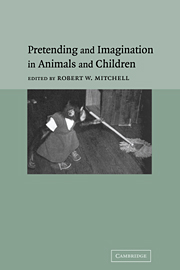Book contents
- Frontmatter
- Contents
- List of contributors
- Foreword by Sue Taylor Parker
- Preface and acknowledgments
- I Historical, developmental, and comparative overviews
- II Pretense and imagination in children
- 4 Language in pretense during the second year: what it can tell us about “pretending” in pretense and the “know-how” about the mind
- 5 A longitudinal and cross-sectional study of the emergence of the symbolic function in children between 15 and 19 months of age: pretend play, object permanence understanding, and self-recognition
- 6 Caregiver-child social pretend play: what transpires?
- 7 Just through the looking glass: children's understanding of pretense
- 8 Young children's understanding of pretense and other fictional mental states
- 9 Pretend play, metarepresentation and theory of mind
- 10 Replica toys, stories, and a functional theory of mind
- 11 Young children's animal-role pretend
- 12 Imaginary companions and elaborate fantasy in childhood: discontinuity with nonhuman animals
- III Pretense and imagination in primates
- IV Prospects
- References
- Author Index
- Subject Index
6 - Caregiver-child social pretend play: what transpires?
Published online by Cambridge University Press: 13 August 2009
- Frontmatter
- Contents
- List of contributors
- Foreword by Sue Taylor Parker
- Preface and acknowledgments
- I Historical, developmental, and comparative overviews
- II Pretense and imagination in children
- 4 Language in pretense during the second year: what it can tell us about “pretending” in pretense and the “know-how” about the mind
- 5 A longitudinal and cross-sectional study of the emergence of the symbolic function in children between 15 and 19 months of age: pretend play, object permanence understanding, and self-recognition
- 6 Caregiver-child social pretend play: what transpires?
- 7 Just through the looking glass: children's understanding of pretense
- 8 Young children's understanding of pretense and other fictional mental states
- 9 Pretend play, metarepresentation and theory of mind
- 10 Replica toys, stories, and a functional theory of mind
- 11 Young children's animal-role pretend
- 12 Imaginary companions and elaborate fantasy in childhood: discontinuity with nonhuman animals
- III Pretense and imagination in primates
- IV Prospects
- References
- Author Index
- Subject Index
Summary
Much of the early research on children's pretend play focused on the young child's ability to generate pretend actions. This research tradition owes its origins to Piaget's (1945/1962) seminal observations of his own children at play. Rich in description, and accompanied by a strong conceptual framework, Piaget's work inspired a series of subsequent studies of children's ability to produce pretend actions during the course of solitary play (for reviews, see Fein, 1981; Bretherton, 1984). Frequently, these studies drew on Piaget's notion of the emerging semiotic function, in particular the young child's ability to distinguish between signifier (e.g., wooden block) and signified (e.g., bar of soap), to explain the accomplishments witnessed in solitary pretend play (Nicolich, 1977; McCune-Nicolich, 1981).
While not repudiating Piaget's approach directly, a different tradition emerged in the latter part of the twentieth century. The focus of researchers in this tradition is pretend play in a social context, particularly pretending in mother-child and child-child dyads. The accompanying conceptual framework, though less explicit than Piaget's, emphasizes the social-cognitive gains that derive from collaborative interactions (see Rogoff, 1990; Cole, 1996). To be sure, an emphasis on social context in symbolic (pretend) play is in itself not new, owing a debt to Vygotsky (1930–1966/1978) and Werner & Kaplan (1963) among others. However, more recent empirical work on pretending in context has added important information about the particular factors that influence social pretend play.
- Type
- Chapter
- Information
- Pretending and Imagination in Animals and Children , pp. 91 - 101Publisher: Cambridge University PressPrint publication year: 2002
- 4
- Cited by



